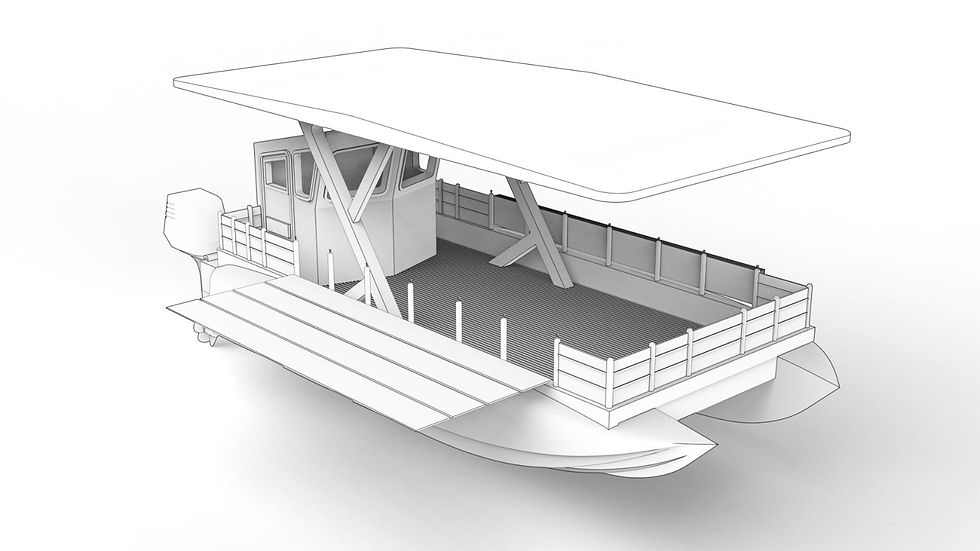
PASSENGER BOAT FOR FLOOD PLAINS
Boat accidents resulting in fatalities have become a pressing issue in India, particularly in regions prone to floods and heavy rainfall.
PASSENGER BOAT FOR
FLOOD PLAINS

HUMANITARIAN CRISIS
Over 10000+ lives effected in 2024 alone due to incidents primarily caused by poor boat construction, overloading, and navigation in adverse weather conditions. The common denominator in these tragedies is the capsizing of boats.
Beyond the immediate tragedy, these incidents have far-reaching consequences for families and communities. The economic burden, the emotional trauma, and the social disruption caused by such accidents are immense.
Addressing this issue is not just about saving lives; it is about improving the quality of life for countless people. It is about creating a safer environment for those who depend on boats for their livelihood and transportation.

Current Design
Chhot boats, commonly used in regions like Assam and Bihar, India, are traditionally constructed using local materials like wood and bamboo. Known for their shallow draft, these boats are well-suited for navigating rivers and wetlands. Their design emphasizes stability and load-carrying capacity, making them suitable for both transportation and fishing. However, these boats often lack modern safety features and are susceptible to damage in harsh conditions, limiting their operational efficiency and safety.
Solution Directions
Prevent capsizing, improve balance on water even with uneven loads or movement.
Enhance Boat Stability
Minimize risk by either spreading or limiting passenger/vehicle loads.
Control Overloading
Make the boat user-friendly for people, goods, and small vehicles.
Improve Loading & Unloading Access
Design fallback measures and structural support for emergencies.
Increase Safety in Case of Capsizing
Make the boat user-friendly for people, goods, and small vehicles.
Improve Loading & Unloading Access
Improve accessibility in tough terrains like swamps, narrow backwaters.
Alternative Mode of Transport
Concept Directions

Flat-Bottom Pontoon
It offers excellent stability and high load capacity, making it suitable for calm, shallow waters. Ideal for carrying passengers and vehicles at low cost.

Catamaran
Its wide beam improves stability and safety, especially when fully loaded, making it perfect for rural backwater transport with minimal risk of capsizing.

Flat-Bottom Skiff
Best suited for light loads, low-speed commutes, and low-cost applications in tight waterways.

Traditional Ferry
While familiar and cost-effective, it is more prone to imbalance under uneven loads compared to multihull designs.
Feature/Aspect | Flat-Bottom Pontoon Boat | Traditional Ferry Boat | Catamaran | Flat-Bottom Skiff |
|---|---|---|---|---|
Manufacturing Cost | Low | High | Moderate | Low |
Stability | High | High | Very High | Moderate |
Shallow Water Navigation | Excellent | Moderate | Good | Excellent |
Passenger Capacity | Moderate | Very High | High | Low |
Capsizing Risk When Overloaded | Moderate | Low | Low | High |
Vehicle Capacity | Moderate | Very High | High | Low |
Ease of Manufacturing | Simple | Complex | Moderate | Simple |
Maintenance Cost | Low | High | Moderate | Low |
Versatility | Good | Good | Good | Fair |
Operational Efficiency | Moderate | High | High | Moderate |
Speed | Moderate | High | High | Moderate |
Environmental Impact | Moderate | High | Low | Moderate |
Self-Righting Capability | Moderate | Low | High | Low |
Suitability for Customization | High | Low | High | Moderate |
Safety Features | Good | Excellent | Excellent | Fair |
Seating Comfort | Good | Excellent | Excellent | Fair |
Loading and Unloading | Simple ramps and tie-downs | Advanced ramps and tie-downs | Advanced ramps and tie-downs | Simple ramps and tie-downs |
The catamaran design offers superior stability, high load capacity, and shallow-water access—making it the safest and most cost-effective solution for rural backwater transport.
KEY DESIGN CONSIDERATIONS
Designing a river boat for shallow waters with enhanced stability and safety features involves several steps and factors to consider in the design process:

01
Hull Design

02
Materials

03
Stability Features

04
Propulsion System

05
Vehicle Accommodation

06
Safety Measures

07
Regulatory Compliance

08
User Comfort
Ideation





Mockup Exploration
















